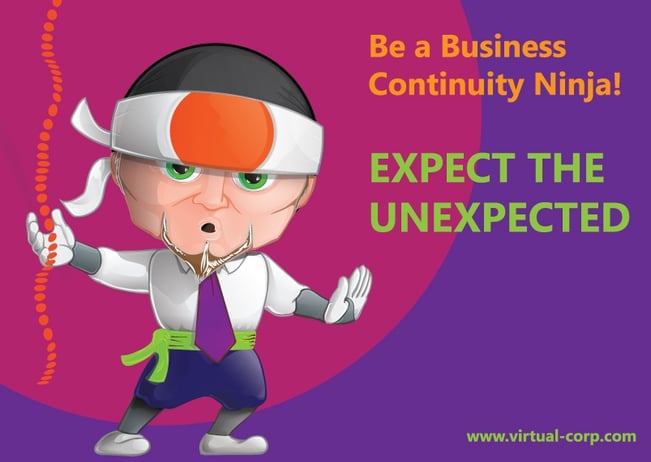5 ways to be a business continuity ninja
You get it. You’re a business continuity manager. You are ready for any disaster. You have ninja like reflexes. You can read minds. You own a magical crystal ball. You have the super power of continuity. You anticipate and avert crisis whenever possible. Of course, this is not always the reality, but you do know how to expect the unexpected.

In too many cases demonstrated by recent history, the worst possible risks tend to be surprises that no one would have suspected as a possibility. Anticipation and foresight can be effective only in situations where we know with high probability the worst risks we face, and we can apply that knowledge to avoid or mitigate negative outcomes. Unfortunately without the help of the super powers and skills set listed above, avoidance and mitigation aren’t always possible. The recent events in NYC, NJ and Minnesota bring to mind the ever increasing need for business continuity and disaster recovery planning. The devastating attacks in Paris, Orlando, New York and across the world are also painful examples of such an unfathomable crisis.
1. Believe it could happen.
Zombie apocalypse, killer clowns, spontaneous combustion, computer virus, human error, natural disaster… anything could happen. (Okay, maybe not some of these, but Hollywood and recent news reports say otherwise.) Anticipate it all. No, I am not saying to have a continuity plan for the Zombie apocalypse, but have a plan that anticipates and mitigates the spread of viruses and bacteria. Have a plan that anticipates an incapacitated workforce. There is a common theme for certain disasters.

2. Anticipate the worst case. Expect the unexpected.
Anticipate the end result of disasters, that is, worst case scenarios or negative impacts to your business or operations. What would you do if your IT infrastructure was compromised? What happens if your facility disappeared or was inaccessible? You don’t have to anticipate the actual event. Look at it from the end result viewpoint and put measures in place to mitigate the impact or optimize recovery. Look at operational impact from every angle – financial, supply chain, distribution, facilities, staffing, technology, power… you get the picture.
3. Apply what you know.
This is where you get to use your business continuity ninja reflexes and super powers – such as your education, experience and analytical skills. Look at scenarios that you have already experienced. What were the results? What were the lessons learned? What best practices have you uncovered? How did you get a handle on the killer clown situation? (Seriously, how do I avoid them!) Ok maybe killer clowns are bit out there, but they sure are in the news a lot lately. The point is look to your own business continuity arsenal for the answers that can help you mitigate, avoid, anticipate and recover.
4. Share. Learn. Communicate.
Communication is essential. Talk to people. What best practices can you learn from your peers? What are the priorities that matter most to each department? What are lessons we can learn from current events? Talking to everyone and researching current/past disasters can shed new light and different perspective on potential disruptive events that could impact the organization. It’s always better to learn from someone else’s mistake.
5. Invite your team to a zombie apocalypse disaster recovery planning party
Don’t wait for a disaster to strike to begin a business continuity or disaster recovery plan. Smart businesses are proactive, from the top of the organization, across all departments and include each stakeholder in the organization. Business Continuity needs to be a priority for the entire organization. The process involves executive leadership, IT, operations, logistics, facilities management, legal, risk management, human resources, sales, marketing and public relations all working together to develop an integrated, actionable plan. Everyone has a stake in the plan’s success. Everyone has a stake in the organization’s success. As a group, you can better determine and expect what might otherwise have been unexpected.
Lesson here? If you flex your business continuity superpowers, use your ninja like reflexes you just might mitigate a Zombie Apocalypse or Killer Clown or real disaster. If you would like some cool tools to add to your BCM arsenal, download these free PPTs: 5 ways to build executive buy-in of your BCM program

